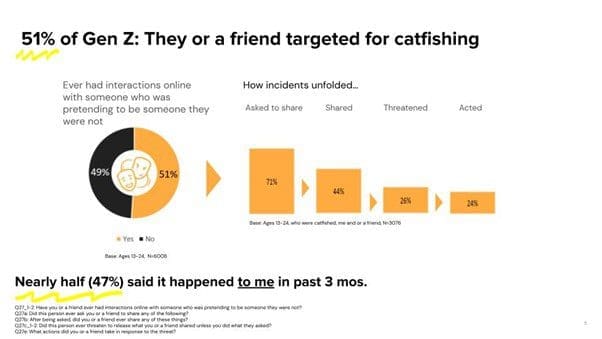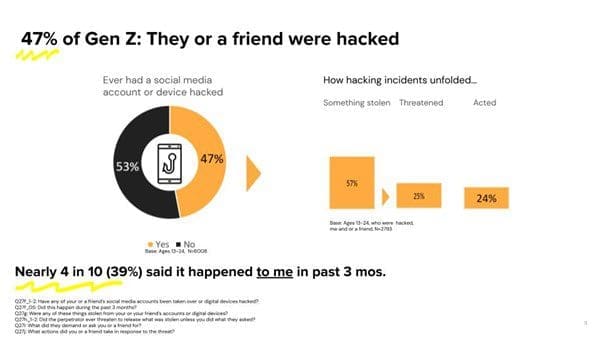Two-thirds of Gen Z targeted for online “sextortion” – New Snap research

Jacqueline Beauchere, Global Head of Platform Safety, Snap Inc. and Board Member of WeProtect Global Alliance, presents findings from new research from Snap, exploring how Gen Z teens and young adults have been targeted in online “sextortion” schemes.
Nearly two-thirds of Generation Z teens and young adults, in six countries, said they or their friends have been targeted in online “sextortion” schemes, new research from Snap Inc. shows.
Sixty-five percent of Gen Z teens and young adults, on all platforms and devices – not just Snapchat — said they or their friends were targeted in online “catfishing” scams, or were hacked by criminals who stole explicit personal imagery or other private information. In both scenarios, the resulting photos and videos were then used to threaten or blackmail the young people, with abusers demanding money, gift cards, more sexual imagery, or other personal information in supposed exchange for not releasing the material to the young person’s family and friends.
- Half (51%) of respondents said they or their friends were targeted for, or victims of, catfishing, and 47% of those cases targeted respondents directly over the prior three months.
- Meanwhile, 47% of respondents said they or their friends’ devices or social media accounts were hacked, with 39% of those instances happening to respondents in the last quarter.
Online “catfishing” occurs when criminals pretend to be someone they are not to lure a victim into sharing personal information or producing sexual imagery. “Hacking,” meanwhile, typically involves a criminal gaining unauthorized access to a victim’s electronic devices or social media accounts to steal intimate photos or other personal information. For the most part, in both schemes, the videos, photos, or other private information are then used to blackmail the victim into acceding to the perpetrator’s demands.
The study is part of Snap’s ongoing research into digital well-being – a measure of Gen Z’s online psychological health across all platforms and devices, not solely Snapchat. Conducted over four weeks in April and May, in Australia, France, Germany, India, the UK and the U.S., more than 6,000 teens and young people participated in the study. We will make additional findings available between now and February when we will release the full results in conjunction with Safer Internet Day 2024. At that time, we will also announce the Year Two reading of Snap’s Digital Well-Being Index.
We are making available this “deeper-dive” into sextortion data to coincide with our participation this week in the Tech Coalition’s biennial Multi-Stakeholder Forum, in partnership with WeProtect Global Alliance and focused on the growing cross-platform harm of financial sextorion.
What was requested
For those survey respondents who cited catfishing as the “hook” into sextortion, 71% said they were asked primarily to share intimate imagery or personal information. In the hacking instances, 57% of respondents said they (or a friend) had something stolen from them. Additional details are noted in the charts below.


Initial “shares” followed by threats and demands
What did those targeted share? About a third (30%) said they revealed personal information, while net 31% shared intimate imagery. A quarter provided other private information, while an encouraging, but still too low, 38% said they shared “none of these things.” Private information refers to details about friends or family members and the like. Scammers may not be looking solely for immediate financial (or other) return from the target. Rather, their goal might be to widen their net to ensnare more people or to try to entice others for sexual relationships or other interactions.
On the hacking side, nearly four in 10 respondents (38%) said perpetrators stole personally identifiable information, while a net 18% took intimate imagery from the target’s accounts. A quarter of respondents said nothing was stolen.
After the initial “share”, threats and blackmail begin. Respondents said perpetrators then demanded something of financial value, like money or gift cards. Offenders also wanted in-person contact or to engage in sexual relationships. Respondents also pointed to demands for additional sexual photos and videos, and access to personal information and online accounts. These follow-on demands occurred in both the catfishing and hacking scenario, according to survey participants.
Seeking help, providing resources
Slightly more encouraging is that nearly six in 10 (56%) of respondents said either they or their friends sought help after being threatened by reaching out to a friend, parent, or another trusted adult. Half (51%) said they reported the incident to the platform, a hotline/helpline, or law enforcement. Nearly 40% (38%) blocked the perpetrator, and smaller percentages took other actions, including updating account security (30%) or closing their accounts (26%).
For those whose devices or accounts were hacked, reporting was the most popular net action (57%), whether to the platform (32%), hotline or helpline (25%), or law enforcement (23%). In addition, more than half (55%) sought help from others, including friends, parents, and other trusted adults.
“For young males who have experienced a sextortion incident — and the majority are males — they regularly tell us that when they share the situation with their parents, they feel relieved (…) We advise them to report to hotlines and helplines; to report to the platforms; and to tell their parents, a friend or a trusted adult. They should not be going through this alone.”
Arda Gerkens, president of Offlimits, the Dutch hotline formerly known as EOKM
Offlimits’ gender assessment bears out in our research. The net percentage of respondents catfished and / or hacked by gender was 56% male and 44% female.
Snap’s actions
At Snap, we make available in-app – and encourage teens and young people to leverage – blocking and reporting tools should members of our community face instances of sextortion. We also recently refined our in-app reporting tool to specifically allow Snapchatters to report sextortion. Now, under the reporting menu for “Nudity or sexual content,” a Snapchatter’s first option is to click, “They leaked / are threatening to leak my nudes.” Our parental supervision feature-set, Family Center, is also designed to spark conversations between teens, parents, caregivers, and others trusted adults about staying safe online.
In the coming weeks, we’ll also be adding new episodes to our Safety Snapshot series to focus on sexual risks and harms, specifically producing modules on financial sextortion; sexting and the consequences of creating and sharing nudes; child online grooming for sexual purposes; and child sex trafficking. By making these resources available to Snapchatters directly in-app, we’re hoping to spark critical thinking at pivotal junctures in the Snapchat experience, like accepting, and starting communications with, new online friends.
Indeed, our overarching objective – as a platform, industry, and multi-stakeholder consortium addressing online risks and harms – should be to tackle these issues before they can even take hold, with a focus on prevention through awareness-raising, education, and cross-platform and cross-sector collaboration.
We are grateful for our involvement in both WeProtect Global Alliance and the Tech Coalition, and we look forward to continued opportunities to conduct research, create and implement new tools, and to raise awareness among and educate all users about these and other potential online risks. We aim to protect Snapchatters and to do our part in safeguarding the overall technology ecosystem so that online learning, growth, and exploration can continue to flourish.
Page last updated on 14th November 2024